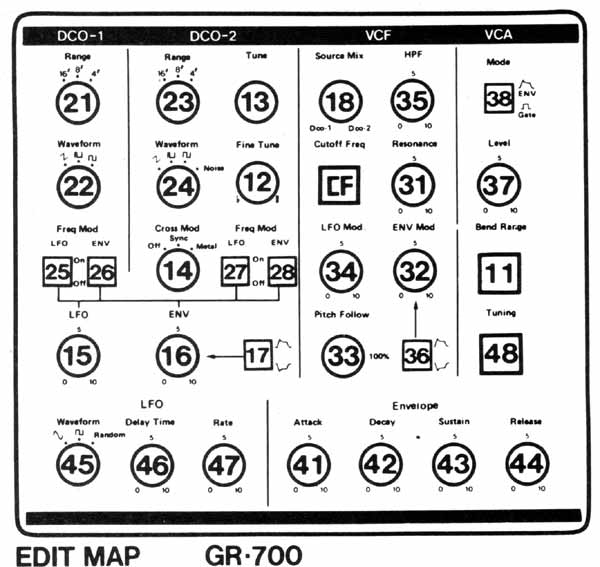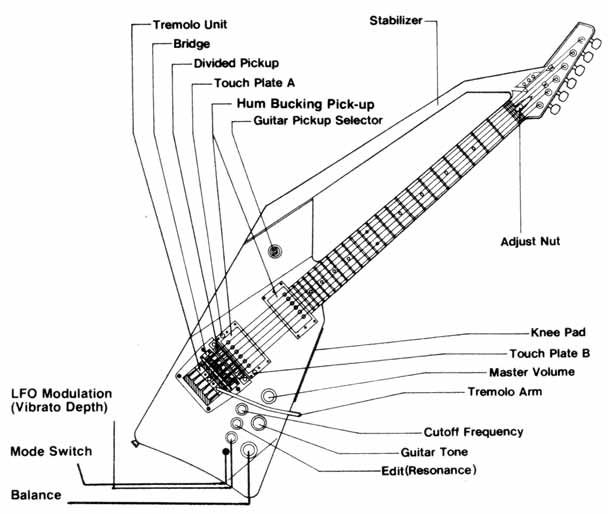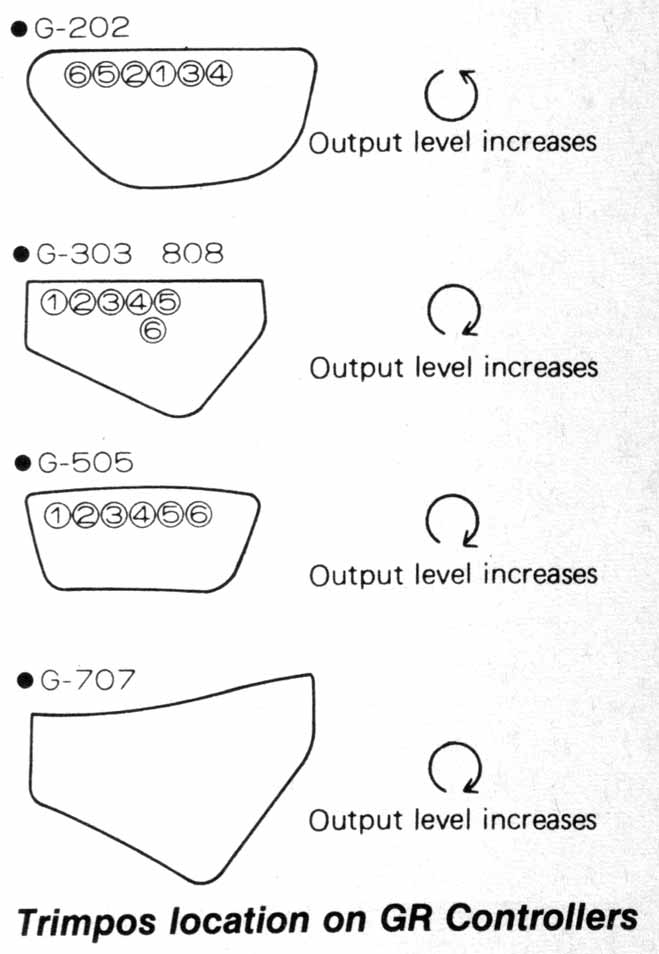|

ROLAND SERVICE
Roland GR Systems: Some Questions and Answers (part 01)
by Mark Altekruse
Roland has been making guitar synthesizers since 1977.
The GR-500 was the first in a line that has also included the GR-100 and GR-300.
The GR-700 was introduced to the public in January of 1984.
As the first programmable polyphonic synthesizer for guitar, the GR-700 has features beyond those of many sophisticated keyboard synthesizers.
Keyboardists have had the opportunity to assimilate the technology of the synthesizer over the last two decades.
Guitarists, for the most part, haven't had that opportunity.
The GR-700 is getting into the hands of more and more people everyday.
These people, unfamiliar with synthesizers, are calling Roland's Service and Product Support departments with a lot of questions.
We've decided to answer, in print, the most often asked questions.
I've tried out the GR-700 and found that it doesn't respond fast enough to my playing. Is there a tracking problem ?
The correct term, in this case, is lag time.
When a string is played on a guitar controller, it vibrates at a certain rate.
A device that counts the vibrations of the string is used to send this information (pitch, on/off, etc.) to the GR-700's oscillators.
The counter is very fast, accomplishing its job within two cycles of the strings vibration.
This complex processing system, when used with certain "patches" on the GR-700, can produce a short lag time.
The lag time can be corrected/ adjusted in two ways.
First, the envelope of the patch and the sensitivity of the guitar controller can be adjusted.
Second, the frets of the guitar could be wired to transmit pitch instantly just like the on/off switching of the keyboard synthesizer.
The first solution is acceptable, but might not totally solve the lag time problem.
The second solution solves the problem, but the guitarist must give up all of the techniques that make his instrument unique; i.e. string bends, hammerons, and harmonics.
After trying the first solution and avoiding the second, what else can be done ?
We've found that if a guitar controller is properly set-up (intonated etc.) and patches and sensitivity are adjusted to compensate for an individual's playing style, 99% of the problems are solved.
What about the 1%? You may have to learn to live with a little lag time.
You may have to learn to "play on top of the beat" like instrumentalists in the back rows of an orchestra must, so that their sound will hit the front row at the same time as the instruments being played from those front rows.
Sometimes while I'm playing I will find that one or two notes that I am sustaining will "jump" octaves by themselves. Is there something wrong with my guitar controller or my synth? If not, what can I do to keep this from happening ?
The octave jumping that you are referring to is called "glitching."
A glitch occurs when the synthesizer module misinterprets the note you are playing or misreads the strings vibration.
The resultant sound is often less than satisfactory, but there is a way to prevent the problem. Since the module is solely dependent on a good, solid string vibration in order to accurately reproduce the note or chord you are playing, it is essential the guitar be in tune with itself !
A guitar controller, or any guitar for that matter, can only be in tune with itself if it has undergone a process known as intonation.
Learning how to intonate a guitar is not difficult. If you are not familiar with the process, we recommend that you see a qualified guitar technician in your area. This service should be performed on a regular basis.
When I try to tune my GR-707 synthesizer to a tuner, I can 't get it to a center of A = 440 Hz. It usually is 10 to 15 cents flat or sharp. Is there something wrong with my module ?
The GR-700 has a P-ROM which allows it to have multiple tuning centers.
This is done because other countries do not use A =440 Hz as their standard. Just like they don't use inches, they use centimeters etc.
The GR-700 is set at the factory for a tuning of A = 442 Hz. It is a very simple process to readjust the module's tuning center.
First, Turn on the GR-700 and wait until the display shows its default Bank and Patch numbers (1/1).
Second, Press the Edit footswitch. The display will read CF on the left side and a percentage number on the right.
Third, Press Edit numbers 4 and 8. This is the tune function of the GR-700.
The display will read 48 in the left and a single number on the right.
Fourth, plug a tuner (BOSS TU-12) in at the MONO Output of the GR-700.
Fifth, Play the first string while depressing the Hold foot-switch. A constant tone will sound.
Sixth, make sure that only the synth sound is audible. Use your Balance control on the controller.
Seventh, Turn the Edit/Resonance control until the meter on your tuner reads exactly A = 440 Hz.
Eighth, Release the Hold and tune the guitar (change your Balance control so you hear the guitar) to the synth module. That's right, the guitar gets tuned to the module.
Ninth, hit the Edit switch again, turn the Memory Protect switch off, hit the Write switch, hit a numbered footswitch and the new tuning center will be stored in memory.
From Roland USERS GROUP magazine 1984
ROLAND SERVICE
Roland GR Systems: Some Questions and Answers (part 02)

I'm using the MIDI Out of the GR-700 into my Juno-106. When I bend a string, the Juno-106 plays only in half step jumps. What's wrong ?
Although the GR-700's internal synthesizer will follow string bends, it will not output this information via MIDI.
There is a chance that new PROMs will be available in the future to make string bending via
MIDI feasible.
Stay tuned for updates, as PROM modifications to your existing unit will be quick, easy, and very inexpensive.
I've tried using my volume pedal to control the VCF and Pitch Bend function on my GR-700. It works, but not great, what gives ?
Your volume pedal probably uses a potentiometer with a value of 250K ohms.
This value is too low to have much effect on your GR-700.
Try using a BOSS FV-200 or another pedal with a rating of 500K ohms or more.
Is it necessary to use a PG-200 to create patches for my GR-700 ?
No, it's just easier. Edits and new patches can be made one parameter at a time using the GR-700's Edit mode. The PG-200 just makes all parameters available for edit simultaneously.
I haven't had much experience with synthesizers. How can I learn more about generating sounds and interfacing ?
Many colleges now offer synthesizer courses through their music departments.
For home study, Roland publishes a four volume series of books entitled The Synthesizer.
It is an in-depth look a synthesis and recording techniques for synthesizers.
Check out the order blank in this issue of RUG for details. Some Roland dealers also stock this set as a service for their customers.
I have a GR-300 and one of your other guitar controllers, a G-505.
I have heard that the GR-300 and your older controllers will not work with the GR-700. Is this true? If it is, how can I interface my system with the GR-700 ?
All that is required to use your GR-300 module with your GR-700 module is a US-2 Unit Selector, which functions like a 24 pin A/B box.
Any of the Roland guitar controllers will work well with the GR-700.
The controls on the instruments have a slightly different function when used with the different modules.
This might make the plastic cover sheet on the G-202, G-303, G-505, and G-808 seem a little confusing.
When using the GR-700 module, the three way mini toggle switch activates two touch sensitivity positions and a guitar only setting.
When editing patches, the Resonance and other controls also take on new functions.
Check your owner's manual for further clarification.
ROLAND SERVICE
Roland GR Systems: Some Questions and Answers (part 03)

Is there a particular brand or type of string that Roland recommends for the GR controllers ?
The choice of strings depends on the style of music and technique of the individual player.
But it is important to use a set of strings that has a uniform "core" between the first wound string and unwound string. For example, on a typically gauged set of light strings, the thicknesses are .10, .13, .17, .26, .36, .46.
For an even response, the core thickness of the third string (.17) and the first wound string, the fourth (.26) should be the same.
If your technique causes an excessive amount of glitching or tracking errors on the lowest string (low E), you may want to substitute a lighter gauge string.
In some cases, a lighter gauge set, perhaps beginning with a .009, would work better for you. Avoid using flat, semi-flat, or tape wound strings.
These strings do not provide a strong enough fundamental note for the synth module.
Remember, if you change string gauges, your controller should be intonated again.
What is that bar on the G-707 ?
The bar is called a stabilizing bar.
The purpose is to eliminate un-wanted neck and body vibration, so that the string can vibrate without interference.
It also lowers the resonant point of the body well below the lowest string's fundamental pitch. This eliminates "dead spots" on the neck.
I have noticed that sometimes when I play relatively soft with my pick or fingers that no sound will occur at the module. Or sometimes when I play hard the module will glitch. Why is this happening ?
A guitar controller is a sensitive instrument which can easily be adjusted to respond to your particular playing style.
As on a standard guitar, the overall height of the synthesizer pickup can be raised or lowered according to the guitarist's playing style and the type of strings being used.
The optimum distance should be within 0.5 mm for the first string and 0.8 for the sixth string.
The next adjustment can be found on the back of the guitar con-troller.

There are a series of six individual trim-pots for adjusting the sensitivity of each string.
Since each controller has a somewhat different layout, the instrument's owner's manual should be consulted to determine which trim-pot is for which string.
Care should be taken not to force the trim-pots past their detents. Damage to the trim-pots can invalidate the instrument's warranty.
On the front of each guitar controller you will find a 3-way mini-toggle switch that can be used to adjust the overall sensitivity of the synth pickup.
In the bottom position, only the sound of the guitar pickups will be available at the synth outputs.
In the middle position, Touch Sensitivity I is located.
This position requires a harder picking style to trigger the synthesizer. In the top or third position, Touch Sensitivity II is activated.
This sensitivity setting only requires a very soft picking technique to trigger the synthesizer.
The key to making the synth react with accuracy is experimentation.
Adjust the guitar and learn which sensitivity setting works best with your style.
Sometimes when I'm playing on my G-707, the GR-700 module will play notes that I haven't played on the guitar. What causes this?
This situation can be corrected in two ways.
First, make sure that the guitar is set-up properly and that the Hex pickup sensitivity has been adjusted for your playing style.
Second, it is important to understand that your GR-700 module is very sensitive.
Your technique should be as clean and precise as possible.
If you touch an adjacent string and it vibrates long enough for the module to read its pitch, the module will respond by playing that note.
Also, many songs require that you play in the open position of the guitar.
Although this may be effective for the song, please be aware that the strings on the controller vibrate just as they do on a normal guitar and they may cause the open strings to vibrate sympathetically.
In short, avoid "ghost notes" and play as often as you can in closed positions on the guitar.
Remember, your fingers now control a synthesizer.
I play a lot of techno-pop and R&B styles. It's necessary to play very staccato notes and chords accompanied with muting techniques. Most of the time when I play like this the GR-700 won't respond to what I'm playing. Is there any way to correct this problem ?
Just as in the preceding question, make sure all adjustments are made to the guitar controller.
The GR-700 will follow most guitar techniques if it receives a strong enough signal.
Extremely short or muted notes may not send enough of the strings vibration for the module to read.
For the styles of music you describe, we recommend that the staccato effect you require be programmed into the GR-700's memory as a patch.
From Roland USERS GROUP magazine 1984
|
|